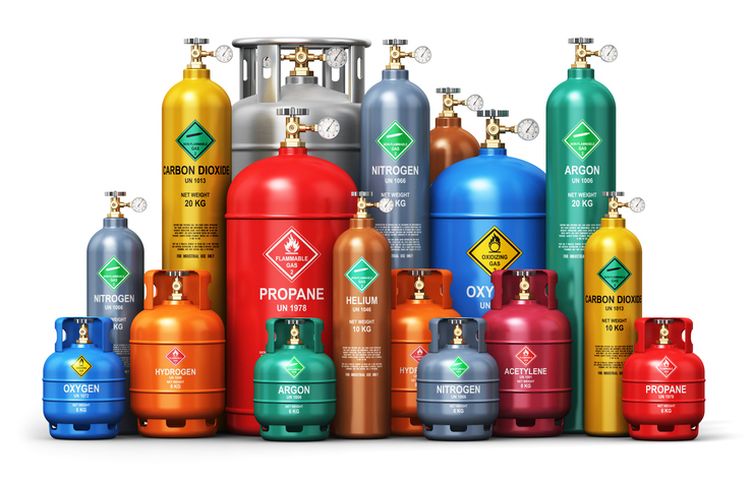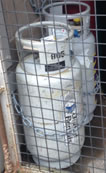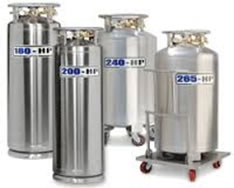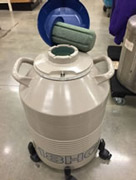All cylinders should bear a cylinder status tag stating one of the three conditions: full, in-service (part full) or empty.

To dispose of your compressed gas cylinders, ask yourself these questions:
Do you own the cylinder or rent it?
RENT: For example, when you procure a gas cylinder from Praxair, you buy the gas but rent the cylinder (pay demurrage).
When you are done with the cylinder, you contact the company listed on the cylinder and they will pick it up.
OWN: If you own the cylinder, skip to the next question.
Is the cylinder empty?
YES: If the cylinder is empty, depending upon original contents, the valve can be removed and the cylinder disposed of as scrap metal.
To recycle empty, vented, and de-valved cylinders as scrap metal, remove or deface all labels, write “empty” on it, and contact UW Recycling to arrange a pickup.
NO: If the cylinder is not empty, but only contains common atmospheric gases such as nitrogen, it may be safely vented and emptied, de-valved and disposed of as scrap metal.
Contact EH&S Environmental Programs for guidance on removing the valve on your particular cylinder. If you are not able or willing to de-valve your cylinder, we can do it for you. There may be a small disposal fee charged for each cylinder. Please provide a budget number with your request.
All other non-rented, non-empty cylinders can be disposed of by submitting an chemical collection request form.
Users of compressed gas cylinders must be familiar with procedures for responding in an emergency. Standard operating procedures (SOPs) for using compressed gases must include possible incident scenarios with appropriate responses.
In the event of a large gas release or other incident, activate the following emergency procedures:
- Evacuate the area, securing entrances and aiding others on the way out.
- Activate building and area fire alarms (or chemical safety alarms if applicable).
- Call 9-1-1.
- Report the incident to a supervisor.
- Follow the EH&S exposure response procedures if potentially exposed to hazardous materials.
- Provide emergency response officials with details of the problem upon their arrival.
Refer to the Compressed Gas Cylinders Safety Guidelines for response procedures for a small gas leak.
Personnel are required to report all incidents to EH&S promptly via the Online Accident Report System (OARS).
The use of manifolds, piping, valves, and/or regulators must follow the Compressed Gas Cylinders Safety Guidelines.
Gases are classified in different ways according to definitions by different regulations including Department of Transportation (DOT) and Fire Code regulations as well as by classification systems such as the Globally Harmonized System of Classification and Labelling of Chemicals (GHS). These classifications are different and overlap in some ways.
Users need to know the hazard classifications of the gases for their SOP(s), training, to plan for storage, to plan for any transport needed, and for addressing fire permits and hazardous materials quantities.
The Fire Code definitions for compressed gases are listed in the Definitions section on this page.
Cylinders stored and used at a University location must be clearly labeled according to U.S. Department of Transportation (DOT) and Occupational Safety and Health Administration (OSHA) regulations.
- The labeling must list contents, concentrations, hazard classifications, safety precautions, and the manufacturer or supplier.
- Do not remove or damage manufacturer applied labels, decals or cylinder content information.
- Be sure to contact the manufacturer if you are unsure of a cylinder's contents.
Additional labeling requirements are described in the Compressed Gas Cylinders Safety Guidelines.

When using gas cylinders, wear closed-toe shoes and safety glasses. Gloves may also be required, depending on the chemical or physical hazards of the gas.
Additional personal protective equipment (PPE) and/or clothing requirements may apply depending on the location and activity. Refer to the Compressed Gas Cylinders Safety Guidelines for more information.
Compressed gas cylinders must be purchased through the preferred supplier, Linde (formerly known as Praxair), to ensure the supplier has a cylinder return authorization program.
All toxic and highly toxic gases are required to be purchased through Praxair, unless unavailable.
Once the new gas cylinders are ordered, the requestor must add the cylinders to their MyChem inventory along with the safety data sheet (SDS) for the gas.
Ordering information is provided on the UW Procurement website.
If the maximum allowable quantity for a control zone is exceeded, the PI/Shop Manager/Responsible Person must apply for a hazardous materials permit from the local fire department. Information on quantities and limits for maximum allowable quantities can be viewed in MyChem.
Refer to the Compressed Gas Cylinders Safety Guidelines for more information on maximum allowable quantities.
Pressure regulators lower the gas pressure to a usable level. There are two kinds of pressure regulator designs, which appear similar: single-stage and two-stage.
- Single-stage regulators are used when precise control of delivery pressure is not required.
- Two-stage regulators give precise control.
Keep regulators clean and free of surface oil and grease, especially oxidizing gases.
Always use the proper regulator for the gas in the cylinder. Connection fittings, stamped Compressed Gas Association (CGA) numbers, plaques and/or decals on the regulator indicate for which gas the regulator is designed.
Do not use Teflon® tape, putty or other such materials on the threads unless specifically required (or applied) by the manufacturer or vendor.
Signage contains important hazard information regarding the gases stored and must be prominently posted in cylinder storage areas.
- A Caution Sign is required to be posted at entrances to laboratories, shops, and maker spaces where hazardous materials are used and/or stored.
- The Fire Code requires rooms or cabinets containing compressed gases to be conspicuously labeled “COMPRESSED GAS.”
The Caution Sign generated in MyChem can be used to meet both of these requirements.
Additional signage may be required based on the cylinder’s contents and related hazards.
Standard operating procedures (SOPs) for using compressed gases must include possible incident scenarios with appropriate responses and must consider the following factors:
- The nature of the operation (e.g., experimental design, equipment used and type of injury that could occur)
- The potential location of a release or spill (e.g., outdoors versus indoors, in a laboratory, corridor or storage area, on a table, in a hood, or on the floor)
- The quantities of material that might be released and the type of containment (i.e., compressed gas tank size, manifold systems, etc.)
- The chemical and physical properties of the compressed gas (e.g., its physical state, vapor pressure and air or water reactivity)
- The hazardous properties of the compressed gas (e.g., its toxicity, corrosivity and flammability)
- The availability and locations of emergency supplies and equipment
The SOP includes an emergency response plan that identifies building evacuation routes, emergency telephone numbers, chemical containment procedures, fire extinguisher usage, etc.
Visit the Chemical SOPs page to download SOP templates, including the Compressed Gas SOP.
All gas cylinders must be firmly secured to a wall with two chains or straps at 1/3 and 2/3 height of the cylinder to prevent toppling due to seismic hazards.Refer to the article Safely store compressed gases and cryogens for information on safe storage.
Cylinders must be in good condition with an operable valve, and capped when not in use. Locate cylinders in a well-ventilated area at least 20 feet apart from incompatible chemicals. All cylinders must be properly labeled.
Review additional storage requirements in the Compressed Gas Cylinders Safety Guidelines.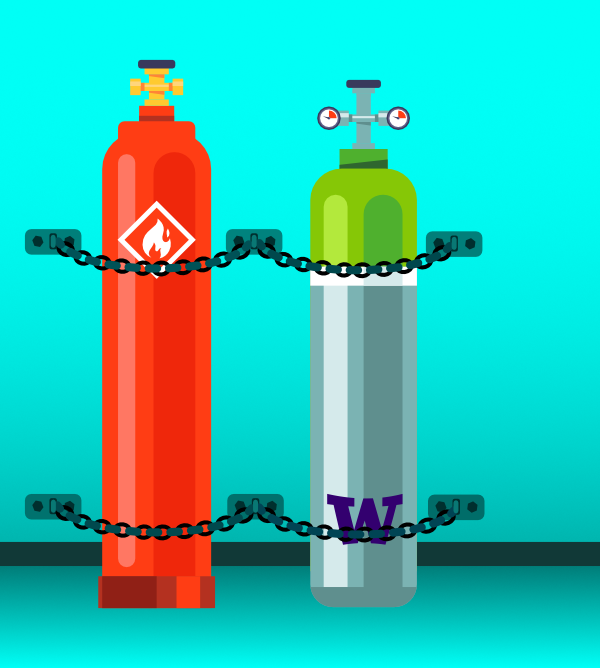
EH&S recommends compressed gas safety training is completed by individuals working with compressed gases prior to handling cylinders.
EH&S offers the following online training courses:
- Compressed Gas Safety for Laboratory Environments
- Compressed Gas Safety (for non-researchers)
- Liquid Nitrogen Safety (required for University personnel working with or around liquid nitrogen)
Gas cylinders and Dewars are particularly vulnerable to damage during transport. Refer to the Gas and Cryogen Transport Focus Sheet for best practices for transporting these materials safely.
Compressed gas cylinders must be handled with caution at all times. Assume all cylinders contain gas under pressure. Treat all gases as hazardous chemicals.
- Read the safety data sheet before you begin using the gas.
- Use cylinders in a well-ventilated area. If you need to use a gas cylinder in spaces with inadequate ventilation, call EH&S at 206.543.7388 to conduct a hazard assessment. Spaces with inadequate ventilation may need oxygen alarms or ventilation failure alarms.
- When turning off the cylinder, turn the gas supply off at the cylinder valve first, depressurize the system, and turn off the regulator.
- Do not use or allow contact with oil or grease on cylinders or their valves.
- Do not empty gas cylinders to a pressure lower than 25 psi (172 kPa). At lower pressures, suction and backflow can cause contamination of residual contents with air if the valve is open.
- Do not use Teflon® tape on cylinder or tube fitting connections, which have metal-to-metal face seals or gasket seals.
Refer to the Compressed Gas Cylinders Safety Guidelines for more information.
